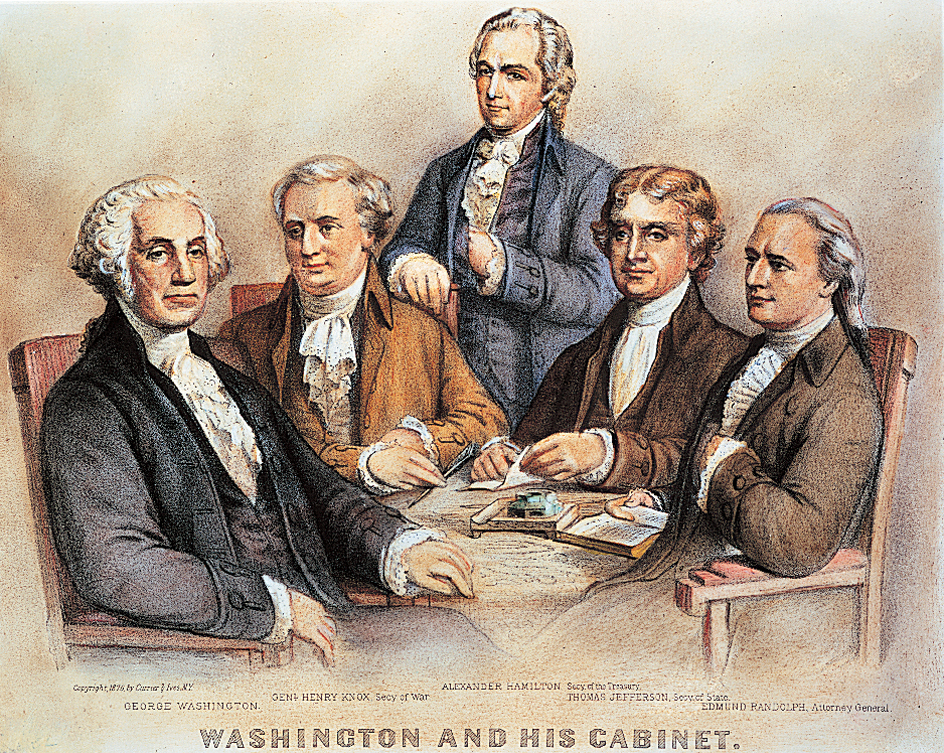Cabinet is a group of advisers who help the head of a government establish policies and make decisions. It nearly always consists of the officials who supervise the executive or administrative work of a government. These officials usually have the title of minister, or secretary, of a department or office. The term cabinet is also used to describe a system of government in which officials who direct the executive work of the government are directly responsible to the legislature.
Cabinet of the United States
Development of the Cabinet.
The Constitution of the United States makes no mention of a Cabinet. In describing the powers of the president, it states that “he may require the opinion, in writing, of the principal officer in each of the executive departments, upon any subject relating to the duties of their respective offices. …” In 1789, Congress established three departments—State, War, and Treasury—and the office of the attorney general. President George Washington frequently consulted with the department heads and the attorney general. The first recorded meeting of this group, held in 1791, included the three secretaries and the vice president. Later, the attorney general and the secretary of the Navy also attended the meetings.

By the early 1800’s, the Cabinet was commonly regarded as consisting of the heads of the existing executive offices. But not until 1907 did a federal statute first use the term cabinet. Some presidents discontinued Cabinet meetings. Andrew Jackson, for example, had a group of advisers known as the “Kitchen Cabinet.”
Membership
in the Cabinet is determined by the president. Today, most people call the heads of the 15 executive departments “the Cabinet.” These heads are the secretaries of agriculture; commerce; defense; education; energy; health and human services; homeland security; housing and urban development; the interior; labor; state; transportation; the treasury; veterans affairs; and the attorney general.
Various presidents have asked other officials in the executive branch of government to take part in Cabinet meetings regularly. In 1961, for example, President John F. Kennedy began to have the U.S. ambassador to the United Nations attend Cabinet meetings. The director of national intelligence and the U.S. trade representative have also served as Cabinet-level officials. The director of the Office of Science and Technology Policy joined President Joe Biden’s Cabinet in 2021.
The president calls Cabinet meetings. The meetings usually take place weekly in the Cabinet Room of the White House.
As department heads, Cabinet members are legal officers of the federal government. The president appoints them with the advice and consent of the Senate, and may dismiss them at any time. They are responsible for administering their departments and carrying out government policies.
By custom, Cabinet members resign when a new president takes office. This procedure enables the new chief executive to select his or her own Cabinet.
Policymaking role
of the Cabinet has varied with different presidents. That role has diminished since the 1960’s because presidents have relied increasingly on smaller advisory groups in making important foreign and domestic policy decisions. For example, economic policy is largely shaped by four people. Of this group, only the secretary of the treasury belongs to the Cabinet. The others are the chairman of the Council of Economic Advisers, the director of the Office of Management and Budget, and the head of the Federal Reserve Board. In matters of foreign policy and defense, the National Security Council plays a more important role than the Cabinet. Many of these smaller, influential groups, including the White House Office, are agencies in the Executive Office of the President.
See the separate articles on each executive department, such as State, Department of. For the order in which Cabinet members succeed to the presidency, see Presidential succession.
For lists of Cabinet members, see the tables with the biographies of presidents of the United States. For example, see Nixon, Richard M. (table: Vice Presidents and Cabinet).
The cabinet system of government
The cabinet system of government is often called the parliamentary system of government. The officers who direct the executive work of the government are directly responsible to the parliament (legislature). In some countries with cabinet systems, the cabinet officials are members of the parliament.
The official head of the government, such as a king, queen, or president, selects the prime minister (sometimes called the chancellor or premier) from the parliament. The prime minister has executive authority in the government (see Prime minister). Advisers to the prime minister help form the ministry (see Ministry). If one party has a majority in the parliament, that party’s leader usually becomes prime minister. The prime minister selects members of his or her party to head the government departments. If no party has a majority, the monarch or president picks a person who can gain the support of a coalition, or combination of parties (see Coalition). In such a cabinet, the prime minister divides the cabinet posts among the supporting parties so that the cabinet will have the support of a majority in the parliament.
A cabinet resigns if it no longer has the support of the parliament. For example, the parliament may refuse to approve a program that the prime minister considers basic. Or it may vote “no confidence” in the cabinet. In each case, the cabinet resigns. The prime minister or his or her successor forms a new cabinet that has the support of parliament. In the United Kingdom, a prime minister who believes that the people support his or her program can dissolve Parliament instead of resigning. The people are then asked to elect a new one. Even with the support of Parliament, a British Cabinet cannot stay in power indefinitely. A prime minister must call a general election after five years in office. Canada and most Commonwealth and European nations have the cabinet system of government.
See also the “Government” section of articles on countries that have the cabinet system of government, such as Norway (Government).
